
Have you been wondering how keyword research is done? It is one of an effective content marketing strategy’s most important but often overlooked aspects. Without optimizing your content for the right keywords, your website and blogs will be nearly impossible to rank well organically in search engines.
Keyword Research allows you to find out what terms people are typing into search engines and how popular those terms are. Understanding this data allows you to optimize your content to reach your target audience.
This comprehensive beginner’s guide to keyword research will walk you through finding ideas, analyzing keywords, and choosing the right keywords. We will also provide tips and strategies together with keyword research tools to lay the foundation for more traffic, leads and sales that you can do on your website or blog.
Part 1:
Keyword Research Basics
Understanding the power of keywords is fundamental to the success of your website or blog. They serve as the foundation upon which your Search Engine Optimization (SEO) strategies are built.
Like anything we do, we must start with a basic understanding of things before we can get into the nitty-gritty.
So, let’s start with the basics of keyword research.
What Is Keyword Research?
Keyword research is a process used in search engine optimization (SEO) to find and analyze the search terms that a user types into search engines like Yahoo, Bing and Google when looking for products, services, or general information. This data can be used to create better content that is more likely to be found by your target audience.
Keyword Research is a way to know more about your target audience and understand what they seek. It’s also a way to discover search engines’ most popular words and phrases.
You may use this information to improve your website or blog by ensuring your content uses the right keywords. The keyword research process ultimately improves its ranking in search engines.
Why Is Keyword Research Important?
Keyword research is important because it lets you understand what people search online.
By understanding what keywords are being used, you can also better optimize your website or blog for those terms and understand what the searcher wants. You can tackle the answers to the questions most people in your audience want answers to.
Effective keyword research can provide insights into current marketing trends and help you centre your content on these topics, which helps you rank higher in SERPs and attract traffic to your website.
Part 2:
How To Find Keyword Ideas
Now we understand what keyword research is and how important it is to your site. But how do you find keyword ideas? There are many tools and methods that you can use to research keywords for your content.
Let’s take a look at how you can effectively find keyword ideas. There are different ways that you can go about finding keywords for your site for free:
1. Brainstorming Keywords
The first and most basic way to develop keyword ideas is to brainstorm them yourself. Think about your target audience and what they may be searching for. Put yourself in their shoes and consider what keywords they would use when looking for your content.
Start by listing our target audience persona, their needs, and what questions they might have.
You can use this as a guide,
- Audience Persona :
- Name:
- Their needs:
- Questions they might have:
Once you have your persona and their needs, brainstorm a list of potential keywords. It can be done with a mind map or just a simple list.
You can also think about the main topics or themes your site covers and develop relevant keywords from there. This method may seem simple, but it can be quite effective in generating initial keyword ideas.
Don’t worry about getting specific at this stage; just come up with as many ideas as possible by putting yourself in their shoes.
You can ask your team members for help; ask them all ideas and questions your target persona might have.
2. Analyze The Competition

Another way to find keyword ideas is by analyzing your competitors. Look at the keywords they use in their content and see if there are any gaps or opportunities for you to target similar keywords.
Review their blog post or check out their sitemap for content ideas.
Example:
If we were looking for ideas for our home décor site, we might check out a competitor’s website like West Elm or Crate & Barrel.
We would then look at their blog posts and see what topics they are writing about. We can also check out their sitemap to get an idea of all the different types of content they have on their site.
Looking at your competitor’s website can give you some great ideas for topics to write about on your site. Also, pay attention to the long-tail keywords your competitors may not target. These longer, more specific phrases can often be easier to rank for but still bring valuable traffic to your site.
If you have a budget for tools, try SEMrush, Ahrefs or other keyword research tools. Through these tools, you can see certain keyword phrases and all other keywords related to the keywords you are trying to rank.
3. Use Keyword Research Tools
Using keyword research tools can be a great way to find new keyword ideas. These tools help you find relevant and high-performing keywords for your content.
Some popular keyword research tools include Google Keyword Planner, SEMrush, Ahrefs, and Moz Keyword Explorer. These tools allow you to search for keywords related to your topic or niche and provide data on search volume, ranking difficulty, and competition.
You can also use these tools to find related keywords and long-tail phrases your competitors may not be targeting. With the right keyword research tool, you can easily generate a list of potential keywords for your content.
4. Check Google Suggest
Google Suggest is a feature in Google’s search engine that can be a great source for keyword ideas, as it shows what people are commonly searching for related to your topic or niche.
As you start typing a query into Google, you will notice that it begins to suggest other possible searches related to your initial query. These suggested search queries can give you some great ideas for targeting additional keywords.
To find these keyword suggestions, start typing your initial query into the Google search bar and then scroll down to the bottom of the page. You will see a list of suggested queries that you can target.
Example:
If we were looking for ideas for our home décor site, we might start by typing “home decor” into the Google search bar.
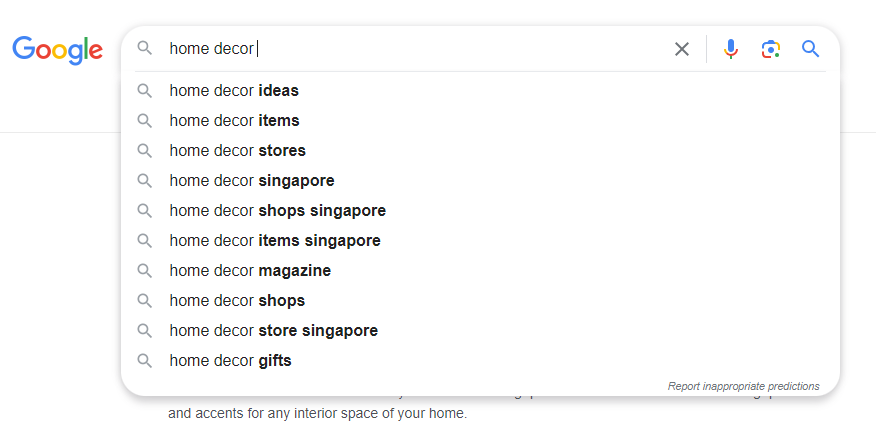
Google would then suggest other related queries such as “home decor ideas”, “home decorating items”, and “home decor stores”.
5. Review “People Also Ask”
When you search in Google, you will see a section called “People also ask.” This section on Google search results shows common questions related to your initial query and can give you additional keyword ideas. “People Also Ask” can give you great ideas for questions to answer in your content.
To do this, search on Google and scroll down to the “People also ask” section. You will see a list of questions people have asked about your topic. You can click on any of these questions to expand and see more related questions.
If you are looking for ideas for our home décor site, you might start by searching for “home decor”.
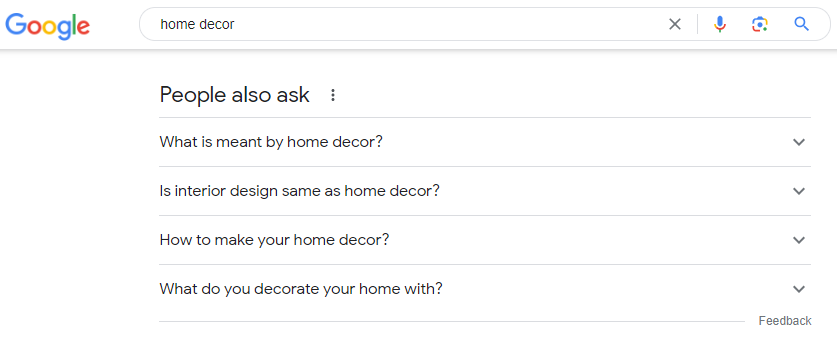
Google would then show you a list of questions in the “People also ask” section, such as “What is meant by home decor?” “Is interior design the same as home decor?” and “How to make your home decor?”.
A tool called AlsoAsked allows you to enter a keyword and see what questions people are asking about that topic.

You can also try AnswerThePublic, a great tool for finding questions that people are asking about a particular topic.
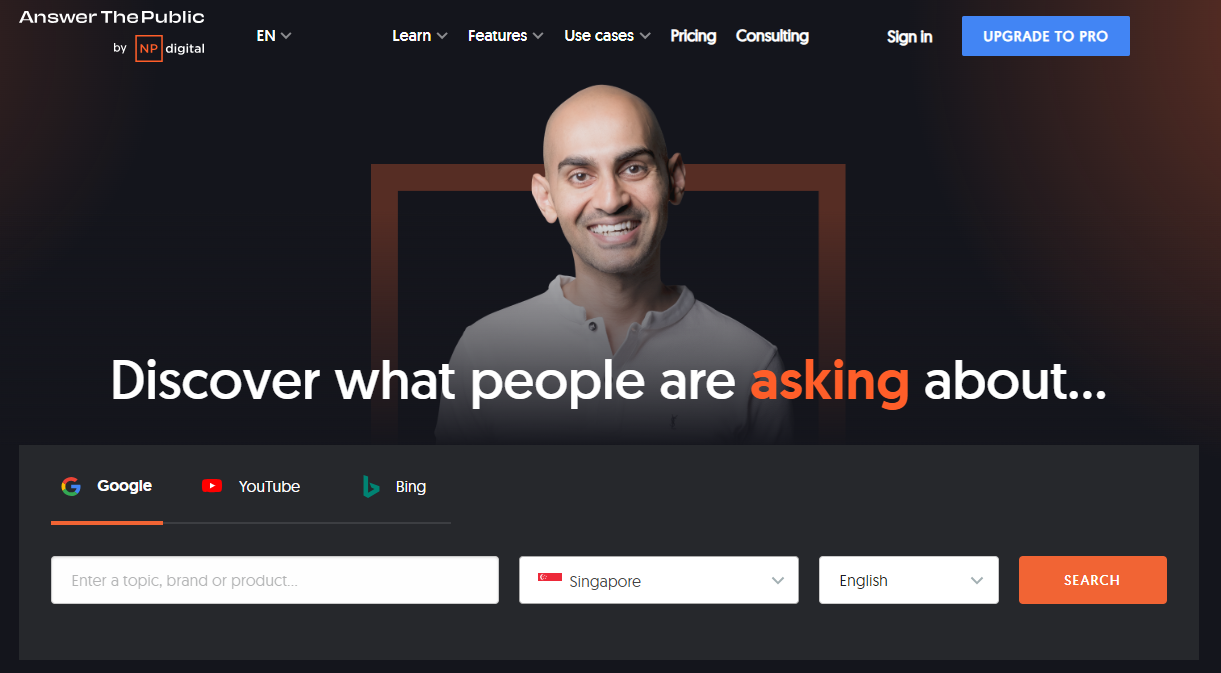
Just enter a keyword to generate a list of questions related to that term.
6. Research Related Search Terms
In addition to using “People Also Ask” and keyword research tools, you can also find new keyword ideas by researching related search terms.
When you search on Google, you might notice a section at the bottom of the results called “Searches related to.” It can give you some great ideas for additional topics to write about.
To find these related topics, search on Google and scroll down to the bottom of the page. You will see a list of related searches that you can target.
Example:
If we were looking for ideas for our home décor site, we might start by searching for “home decor”.
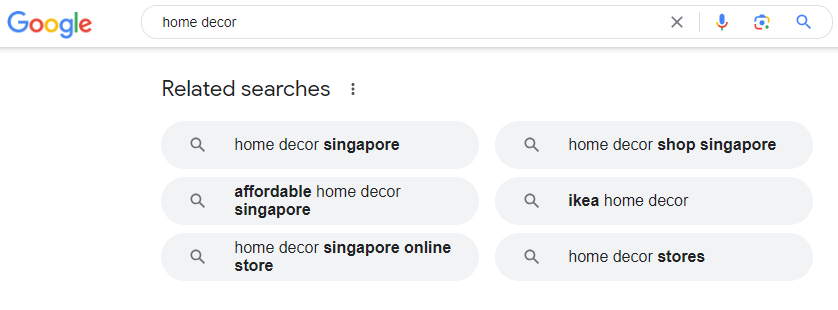
Google would then show us a list of related searches such as “affordable home decor”, “home decor shop”, “ikea home decor”, and “home decor stores”.
You can utilize all these tools to get more keyword ideas for your business.
Part 3:
How To Analyze Keywords
Now that you have a question and keyword list, how do you determine which ones to target? It is where you need to do some keyword analysis.
Keyword analysis is researching and analyzing keywords to determine their relevance, competition, and potential for driving traffic. Doing this lets you identify valuable keywords to target in your content and optimize it for search engines.
Here are a few things to consider when analyzing keywords:
Search Volume
The first thing you want to look at is the Search Volume for each keyword. It indicates the number of times a keyword is searched for within a given timeframe. Search volume will give you an idea of how many people are actually searching for that term.
You can get an idea of the search volume for a keyword using Google Keyword Planner. Just enter a keyword, which will give you an estimated range of monthly searches for that term.
You can also try Google Trends to see how the popularity of a particular keyword has changed over time.
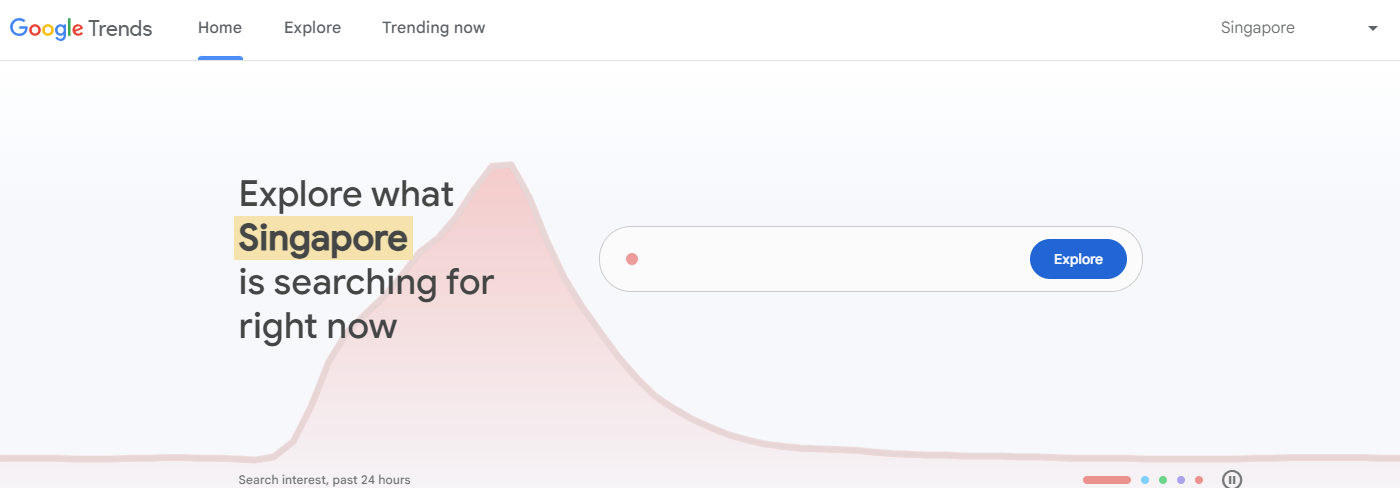
It is helpful to see if there is potential for growth in the search volume for a particular keyword.
High search volume keywords are often highly competitive, and ranking for them could attract significant visitors. Nonetheless, lower search volume keywords shouldn’t be dismissed outright as they often represent niche markets with less competition, offering opportunities for highly targeted, quality traffic.
Keyword Difficulty
Another thing you can look at is the Keyword Difficulty. It measures how difficult it would be to rank for a particular keyword. It takes into account the strength of your competitors and their ranking positions.
The keyword difficulty ranges from 1 to 100, with 1 being the easiest to rank for and 100 being the most difficult.
You have to target keywords with a reasonable search volume that is not too difficult to rank for. A good rule of thumb is to target keywords with a keyword difficulty of less than 50.
You can check the keyword difficulty using several different tools, but most are not free keyword research tools. Some of the popular keyword difficulty tools are Moz, Ahrefs and SEMrush.
It is crucial to consider the keyword difficulty when choosing which keywords to target. It would be best to balance high search volume and low competition keywords to maximize your chances of ranking high in SERPs.
Short-Tail Keywords
You can group your keywords, starting with short-tail keywords. Short-tail keywords, also known as head terms or broad keywords, are usually one or two words long. They have high search volumes and attract a lot of traffic.
An example of a short-tail keyword is “keyword research.”
While targeting short-tail keywords may seem attractive because of their high search volume, they also come with fierce competition. Big brands often dominate these keywords, making it challenging for smaller websites to rank for them.
Mid-Tail Keywords
Mid-tail keywords are more specific, usually between two to three words long. These keywords have lower search volumes and competition compared to short-tail keywords.
An example of a mid-tail keyword is “keyword research tools.”
Targeting mid-tail keywords can help you reach a more targeted audience while attracting decent traffic. These keywords can be a good option to target if you are just starting with SEO.
Long-Tail Keywords
Long-tail keywords are longer keyword phrases with three or more words. These keywords have low search volumes and competition but often convert better because they target a specific audience.
An example of a long-tail keyword is “how to do keyword research for a blog.”
Long-tail keywords are generally easier to rank for because there is less competition. It can be a great way because you can start ranking for these keywords relatively quickly.
Click-Through-Rate (CTR)
The click-through rate (CTR) is the number of people who click on your listing in the search results divided by the total number of people who see your listing.
For example, if your listing is shown 100 times and you get five clicks, your CTR would be 5%.
This metric is important because it can give you an idea of how relevant your listing is for a particular keyword. Even if you rank high for a keyword, if your CTR is low, you won’t see much traffic from that keyword. That’s why it is crucial to choose keywords that have a high CTR potential.
The higher your CTR, the more likely you are to rank for the right keyword.
You can review your CTR in Google Search Console, go to Search Traffic > Search Analytics and then filter by clicks and impressions.
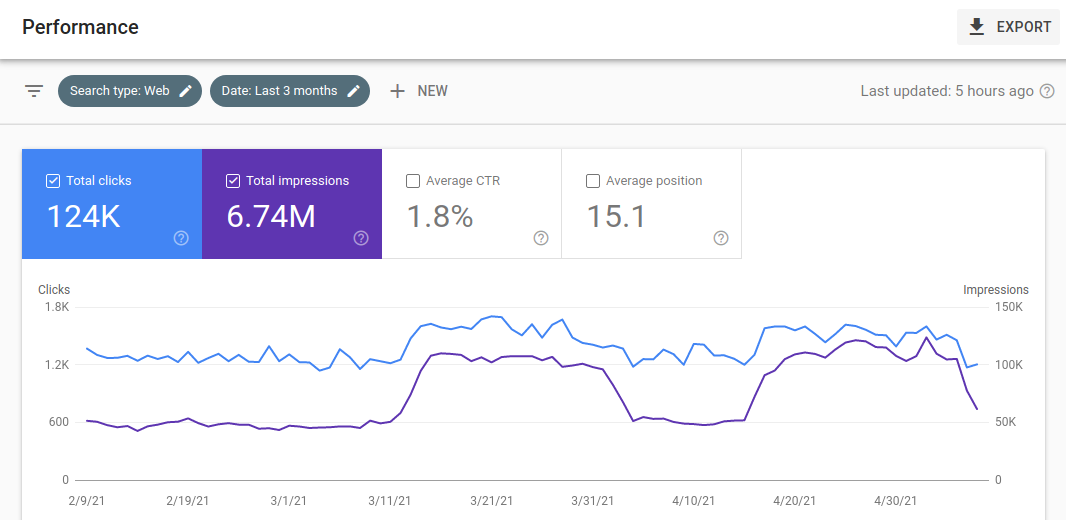
This will show you the CTR for each of your listings in the search results.
Traffic Potential
The traffic potential is the number of people who could potentially click on your listing in the search results. It differs from the CTR because it includes people who see your listing but don’t click on it.
Understanding this potential can be crucial in keyword analysis as it allows you to gauge the popularity and demand for specific keywords. It helps you assess if targeting a particular keyword is worth the effort based on its ability to drive significant organic traffic.
For example, if your listing is shown 100 times and you get five clicks, your traffic potential would be 100.
If your traffic potential is high, but you have a low CTR, it could indicate that your listing is irrelevant to the keyword you are targeting.
You can check your traffic potential in Google Search Console. Just go to Search Traffic > Search Analytics and then filter by impressions.
It will show you the traffic potential for each of your listings in the search results.
Cost Per Click (CPC)
The cost per click (CPC) is the amount of money you would pay for each person who clicks on your listing in the search results. It’s an essential metric for advertisers using paid search ads to target keywords.
However, it also has relevance in keyword analysis for organic search as it can provide insights into the value and competition of a particular keyword.
For example, if you pay $1 per click and get five clicks, your CPC would be $5.
This metric is important because it can give you an idea of how much it would cost to get traffic from a particular keyword. Keywords with higher CPCs usually mean more competition, making it challenging to rank organically for those keywords.
You can check your CPC in Google AdWords. Go to Keywords > Ad group ideas and then filter by average CPC.
It will show you the CPC for each of your keywords.
Using tools like Ahrefs, you can see all these metrics in one place.
Go to Keywords > Overview and filter by Difficulty, CPC, Volume and Traffic.
It will show you a list of all the keywords you are targeting, their difficulty, CPC, volume and traffic potential.
Part 4:
How To Choose the Right Keywords
After analyzing your keywords based on the abovementioned things, you must choose the right keywords to target. It is crucial as it can make or break your SEO efforts.
There are a few things you need to keep in mind when doing this:
Relevancy
The first thing you need to consider is the relevancy of the keywords to your website or business. It’s important to choose keywords that align with the content you have on your website to attract the right kind of visitors.
The visitors you attract need to be interested in what you offer. Otherwise, they will not convert into customers or clients, leading to a high bounce rate and low conversion rates.
For example, if you are a blog about dogs, you wouldn’t want to target keywords like “cat food” or “pet supplies.”
You want to make sure that the keywords you are targeting are relevant to your business.
Search Intent
The second thing you need to consider is the search intent. What are people looking for when they search for those specific keywords?
Make sure that the keywords you are targeting have the right intent. Search intent is the motivation behind a particular search. This is the reason why someone is searching for something.
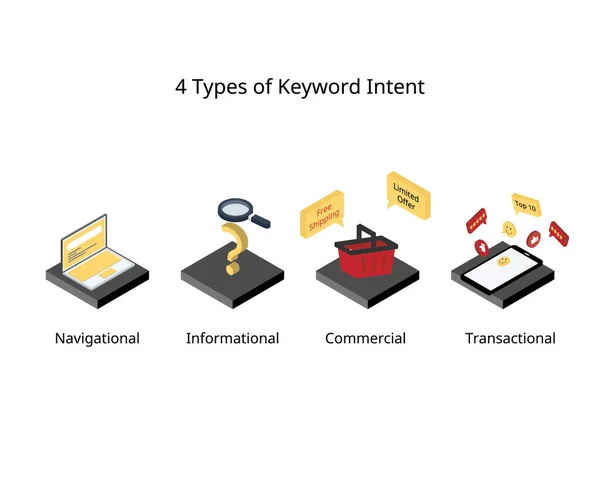
There are four types of search intent:
– Informational: The user is looking for information about a topic.
– Navigational: The user is looking for a specific website.
– Transactional: The user is looking to buy something.
– Commercial: The user is looking to compare prices or find a coupon before making a purchase
For example, if someone is searching for “SEO services,” they are probably looking to hire an SEO company.
If someone is searching for “SEO tips,” they might just be looking for information and not necessarily looking to hire an SEO company.
Therefore, you would want to target keywords with commercial intent like “SEO services” over keywords with informational intent like “SEO tips.”
You can check the intent of a keyword by looking at the search results.
To do this, you can go to Google and search for your keyword. “SEO Services,” for example, type this in the Google search bar.
Then, look at the search results and see what websites rank for that keyword.
If you see many websites that are selling products or services, then it’s likely that the keyword has commercial intent.
If you see a lot of blog posts and articles, then it’s likely that the keyword has informational intent.
Authority
The last thing you must consider when choosing the right keywords is your website’s authority. It refers to how trustworthy and credible your website is in the eyes of search engines.
Building authority for your website takes effort and time, but it’s crucial as it can greatly impact your search engine rankings.
When choosing keywords, try to balance between high-competition keywords that are more difficult to rank for but have high search volume and low-competition keywords with lower search volume but are easier to rank.
It is also important to consider the authority of your competitors. If you are a new website, competing with well-established websites for highly competitive keywords might be harder. In this case, targeting long-tail keywords or niche keywords can be a more effective strategy.
Part 5:
Advanced Tips and Strategy
In the previous sections of this guide, we have covered the basics of keyword research and how it is essential for developing a successful SEO strategy. However, some advanced tips and strategies can take your keyword research to the next level.
Here are some tips and strategies we do in Aemorph as we do our keyword research.
Keyword Gap Analysis
Keyword gap analysis is a powerful technique that helps you uncover untapped keyword opportunities. It involves comparing your website’s keyword rankings with your competitors, identifying the gaps in their keyword strategy and incorporating those keywords into your own strategy.
It allows you to target new, relevant keywords that your competitors may not yet target.
We use Google Sheets to do a Keyword Gap Analysis for our clients, and we can input up to 15 competitors at a time to analyze and find out what keywords our client does not rank for yet.
Ahrefs also does a Keyword Gap Analysis. Just go to Site Explorer > Enter your URL > Content Gap. You can enter up to 10 competitors to analyze.
It will show you all the keywords your competitor is ranking for.
Keyword Cannibalisation
Keyword cannibalization is a situation that occurs on your website where multiple pages target the same keyword. It causes them to compete against each other in search engine rankings.
It can lead to decreased organic traffic and confusion for search engines as they need help determining which page should rank higher for the specific keyword.
To avoid this issue, we recommend conducting regular audits of your content to identify any instances of keyword cannibalization.
You can also use SEO tools like Screaming Frog or SEMrush to identify website pages competing for the same keyword.
Once identified, you can consolidate these pages into one comprehensive piece of content and redirect the other pages accordingly.
Part 6:
Keyword Research Tools
When it comes to keyword research, many tools can help you find the right keywords for your website. These tools use techniques and strategies to list relevant keywords you can target in your content.
Here are some of the best keyword research tools. Let’s go through each free and paid tool we can use for our keyword research:
Google Trends
Google Trends is one of the free keyword research tools that shows you the relative search volume of keywords over time. It also provides related queries and rising trends, giving you a better understanding of what people are searching for.
Google Trends is useful to see if a keyword is growing or declining in popularity. You can also use this to compare multiple keywords and see which one is more popular.
Google Keyword Planner
Google Keyword Planner is one of the free keyword research tools that shows you the average monthly search volume for keywords. It helps you find new keyword ideas and provides search volume data.
To use Google Keyword Planner, you need to have a Google Ads account.
Answer the Public
Answer the Public is another free keyword research website that shows you the questions people are asking about a certain keyword. It is useful to find new content ideas or find new keywords to target, allowing you to create content that addresses their queries.
Moz Keyword Explorer
Moz Keyword Explorer is a paid keyword research tool that shows you the monthly search volume, difficulty, and opportunity for keywords. It also provides other information like organic click-through rate, priority score, etc. Moz also has a free keyword research tool called MozBar.
Ahrefs Keywords Explorer
It is one of the best keyword research tools for us. The Ahrefs Keywords Explorer is a paid keyword research tool that shows you the monthly search volume, difficulty, and opportunity for keywords. It also shows additional information like top countries and languages for a particular keyword.
To use Ahrefs Keywords Explorer:
1. Log in to Ahrefs and go to keyword Explorer.
2. Type in the keyword or the keywords you want to check.
3. Choose the target country and hit search. It will bring out all the data you want about that particular keyword, such as search volume, KD or Keyword Difficulty, etc.
SEMrush
SEMrush is another paid keyword research tool that provides in-depth keyword data such as monthly search volume, CPC (cost-per-click), and competition level. It also shows you related keywords, phrase match keywords, and more.
To use SEMRush,
- Log in to your SEMRush account and go to Keyword Analytics > Overview.
- Type in the keyword you want to check and hit search.
Ubersuggest
Ubersuggest is a free keyword research tool with keyword suggestions, search volume data, and competition level. It also provides additional information like top page ranking for the keywords, backlinks, etc.
There are a lot of other keyword research tools out there, and the ones we’ve listed above are the free ones and some of our favourite keyword research tools.
Keyword Research FAQ’s
How keyword research is important in SEO?
Keyword research is important in SEO as it helps identify people’s words and phrases to search for information related to products, services, or industries. This information is used to optimize a website’s content, improve its visibility in SERPs, attract traffic, increase authority, and ultimately lead to more conversions and revenue.
What is the best keyword research tool for SEO?
Several effective keyword research tools for SEO include Google Keyword Planner, SEMrush, Ahrefs, Moz’s Keyword Explorer, and others. The best tool for a specific situation depends on the user’s needs, budget, and required features.
How many keywords should I use for SEO?
There is no specific number of keywords that should be used for SEO. Instead, it’s important to focus on using relevant keywords that reflect the page’s content and the target audience’s interests. Quality and relevance are more important than quantity when it comes to keywords.
How many keywords is too much?
Using too many keywords, especially if irrelevant or spammy, can harm the user experience and lead to a website penalty by search engines. It’s important to focus on using a moderate number of relevant keywords that naturally fit into the content.
How do you solve keyword cannibalization?
Keyword cannibalization can be solved by consolidating content, setting up proper redirects, using canonical tags, and clarifying the focus of each page. It’s important to ensure that each page targets a unique set of keywords and provides distinct value to the users.
How many keywords should I be tracking?
The number of keywords to track depends on the website’s size, goals, and available resources. It’s important to track the most relevant and high-potential keywords that align with the website’s objectives and target audience.
Implementing Keyword Research
Keyword research is a vital part of SEO to find the right keywords that bring you traffic and help you rank higher on the search results page. You can optimise your website’s content using techniques like keyword gap analysis and avoiding keyword cannibalization.
Utilise free tools like Google Keyword Planner to get started doing keyword research, but we recommend using paid tools like Ahrefs and Semrush if you have the budget. It’s essential to research and find the best tools that suit your needs.
You can regularly conduct keyword research to audit and refresh your content or update your keyword and content strategy. Alternatively, leverage an experienced SEO team so you can hands-off drive more organic traffic and increase conversions to your website.









